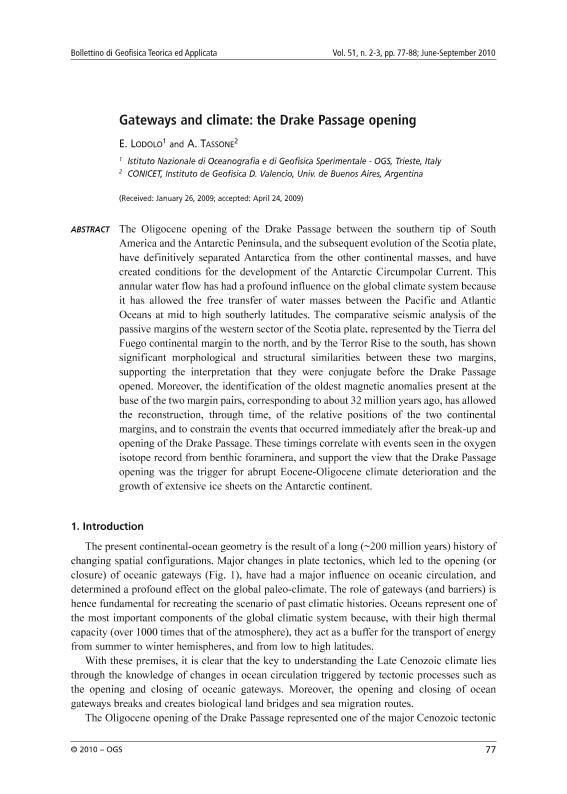Mostrar el registro sencillo del ítem
dc.contributor.author
Lodolo, Emanuele

dc.contributor.author
Tassone, Alejandro Alberto

dc.date.available
2019-01-29T15:21:25Z
dc.date.issued
2010-06
dc.identifier.citation
Lodolo, Emanuele; Tassone, Alejandro Alberto; Gateways and climate: The Drake Passage opening; Istituto Nazionale di Oceanografia e di Geofisica; Bollettino di Geofisica Teorica ed Applicata; 51; 2-3; 6-2010; 77-88
dc.identifier.issn
0006-6729
dc.identifier.uri
http://hdl.handle.net/11336/68849
dc.description.abstract
The Oligocene opening of the Drake Passage between the southern tip of South America and the Antarctic Peninsula, and the subsequent evolution of the Scotia plate, have definitively separated Antarctica from the other continental masses, and have created conditions for the development of the Antarctic Circumpolar Current. This annular water flow has had a profound influence on the global climate system because it has allowed the free transfer of water masses between the Pacific and Atlantic Oceans at mid to high southerly latitudes. The comparative seismic analysis of the passive margins of the western sector of the Scotia plate, represented by the Tierra del Fuego continental margin to the north, and by the Terror Rise to the south, has shown significant morphological and structural similarities between these two margins, supporting the interpretation that they were conjugate before the Drake Passage opened. Moreover, the identification of the oldest magnetic anomalies present at the base of the two margin pairs, corresponding to about 32 million years ago, has allowed the reconstruction, through time, of the relative positions of the two continental margins, and to constrain the events that occurred immediately after the break-up and opening of the Drake Passage. These timings correlate with events seen in the oxygen isotope record from benthic foraminera, and support the view that the Drake Passage opening was the trigger for abrupt Eocene-Oligocene climate deterioration and the growth of extensive ice sheets on the Antarctic continent.
dc.format
application/pdf
dc.language.iso
eng
dc.publisher
Istituto Nazionale di Oceanografia e di Geofisica

dc.rights
info:eu-repo/semantics/openAccess
dc.rights.uri
https://creativecommons.org/licenses/by-nc-sa/2.5/ar/
dc.subject
Scotia
dc.subject
Drake Passage
dc.subject
Gateways
dc.subject
Climate
dc.subject.classification
Meteorología y Ciencias Atmosféricas

dc.subject.classification
Ciencias de la Tierra y relacionadas con el Medio Ambiente

dc.subject.classification
CIENCIAS NATURALES Y EXACTAS

dc.title
Gateways and climate: The Drake Passage opening
dc.type
info:eu-repo/semantics/article
dc.type
info:ar-repo/semantics/artículo
dc.type
info:eu-repo/semantics/publishedVersion
dc.date.updated
2019-01-28T14:04:24Z
dc.journal.volume
51
dc.journal.number
2-3
dc.journal.pagination
77-88
dc.journal.pais
Italia

dc.journal.ciudad
Trieste
dc.description.fil
Fil: Lodolo, Emanuele. Istituto Nazionale di Oceanografia e di Geofisica Sperimentale; Italia
dc.description.fil
Fil: Tassone, Alejandro Alberto. Consejo Nacional de Investigaciones Científicas y Técnicas. Oficina de Coordinación Administrativa Ciudad Universitaria. Instituto de Geociencias Básicas, Aplicadas y Ambientales de Buenos Aires. Universidad de Buenos Aires. Facultad de Ciencias Exactas y Naturales. Instituto de Geociencias Básicas, Aplicadas y Ambientales de Buenos Aires; Argentina. Universidad de Buenos Aires. Facultad de Ciencias Exactas y Naturales. Departamento de Geología. Instituto de Geofísica "Daniel Valencio"; Argentina
dc.journal.title
Bollettino di Geofisica Teorica ed Applicata

dc.relation.alternativeid
info:eu-repo/semantics/altIdentifier/url/http://www3.ogs.trieste.it/bgta/provapage.php?id_articolo=478
Archivos asociados
